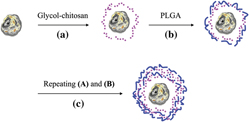Crossref Citations
This article has been cited by the following publications. This list is generated based on data provided by
Crossref.
Bulwan, Maria
Antosiak‐Iwańska, Magdalena
Godlewska, Ewa
Granicka, Ludomira
Zapotoczny, Szczepan
and
Nowakowska, Maria
2013.
Chitosan‐Based Nanocoatings for Hypothermic Storage of Living Cells.
Macromolecular Bioscience,
Vol. 13,
Issue. 11,
p.
1610.
Watson, Melanie G.
Lopez, Juan M.
Paun, Mihaela
and
Jones, Steven A.
2013.
A novel dynamic layer-by-layer assembled nano-scale biointerface: functionality tests with platelet adhesion and aggregate morphology influenced by adenosine diphosphate.
Journal of Thrombosis and Thrombolysis,
Vol. 36,
Issue. 4,
p.
448.
Li, Zhihua
Zhang, Yanwu
and
Shi, Zhaohui
2013.
Hydrothermal synthesis of nanowires, nanobelts, and nanotubes of vanadium oxides from one reaction system.
International Journal of Materials Research,
Vol. 104,
Issue. 6,
p.
567.
Lybaert, Lien
De Vlieghere, Elly
De Rycke, Riet
Vanparijs, Nane
De Wever, Olivier
De Koker, Stefaan
and
De Geest, Bruno G.
2014.
Bio‐Hybrid Tumor Cell‐Templated Capsules: A Generic Formulation Strategy for Tumor Associated Antigens in View of Immune Therapy.
Advanced Functional Materials,
Vol. 24,
Issue. 45,
p.
7139.
2014.
Biofunctional Surface Engineering.
p.
24.
Yan, Jianhua
Liu, Xingbo
and
Li, Bingyun
2014.
Recent progress in Li-rich layered oxides as cathode materials for Li-ion batteries.
RSC Adv.,
Vol. 4,
Issue. 108,
p.
63268.
Ghosh, Paulomi
Kapat, Kausik
and
Dhara, Santanu
2015.
Surface Modification of Biopolymers.
p.
194.
Kim, Hyeongmin
and
Lee, Jaehwi
2016.
Strategies to Maximize the Potential of Marine Biomaterials as a Platform for Cell Therapy.
Marine Drugs,
Vol. 14,
Issue. 2,
p.
29.
Thiel, Anne
Mogel, Helga
Bruggisser, Julia
Baumann, Arnaud
Wyder, Marianne
Stoffel, Michael
Summerfield, Artur
and
Posthaus, Horst
2017.
Effect of Clostridium perfringens β-Toxin on Platelets.
Toxins,
Vol. 9,
Issue. 10,
p.
336.
Andreini, Derek E.
Werner, Zachary J.
Bell, Christopher D.
Xing, Malcolm
and
Li, Bingyun
2017.
Orthopedic Biomaterials.
p.
247.
Zhang, Shichao
Xing, Malcolm
and
Li, Bingyun
2018.
Biomimetic Layer-by-Layer Self-Assembly of Nanofilms, Nanocoatings, and 3D Scaffolds for Tissue Engineering.
International Journal of Molecular Sciences,
Vol. 19,
Issue. 6,
p.
1641.
Hasturk, Onur
and
Kaplan, David L.
2019.
Cell armor for protection against environmental stress: Advances, challenges and applications in micro- and nanoencapsulation of mammalian cells.
Acta Biomaterialia,
Vol. 95,
Issue. ,
p.
3.
Liu, Tengfei
Wang, Ying
Zhong, Wen
Li, Bingyun
Mequanint, Kibret
Luo, Gaoxing
and
Xing, Malcolm
2019.
Biomedical Applications of Layer‐by‐Layer Self‐Assembly for Cell Encapsulation: Current Status and Future Perspectives.
Advanced Healthcare Materials,
Vol. 8,
Issue. 1,
Ghanavi, Jalaledin
Farnia, Poopak
and
Velayati, Ali Akbar
2019.
Nanoarchitectonics in Biomedicine.
p.
547.
Hasturk, Onur
Sahoo, Jugal Kishore
and
Kaplan, David L.
2020.
Synthesis and Characterization of Silk Ionomers for Layer-by-Layer Electrostatic Deposition on Individual Mammalian Cells.
Biomacromolecules,
Vol. 21,
Issue. 7,
p.
2829.
Hasturk, Onur
Rodriguez, Maria J.
Wheeler, John J.
Venoor, Varun
Sobkowicz, Margaret J.
and
Kaplan, David L.
2021.
Silk nanocoatings of mammalian cells for cytoprotection against mechanical stress.
MRS Bulletin,
Vol. 46,
Issue. 9,
p.
795.
Liu, Lianmeng
Liang, Wenlong
Zhang, Yabo
and
Fu, Qiang
2023.
Nanoencapsulation in polymeric materials: Weaving magical coats for microorganisms.
Nano Today,
Vol. 52,
Issue. ,
p.
101973.
Borges, João
Zeng, Jinfeng
Liu, Xi Qiu
Chang, Hao
Monge, Claire
Garot, Charlotte
Ren, Ke‐feng
Machillot, Paul
Vrana, Nihal E.
Lavalle, Philippe
Akagi, Takami
Matsusaki, Michiya
Ji, Jian
Akashi, Mitsuru
Mano, João F.
Gribova, Varvara
and
Picart, Catherine
2024.
Recent Developments in Layer‐by‐Layer Assembly for Drug Delivery and Tissue Engineering Applications.
Advanced Healthcare Materials,
Vol. 13,
Issue. 8,



